#Crab nebula
Text

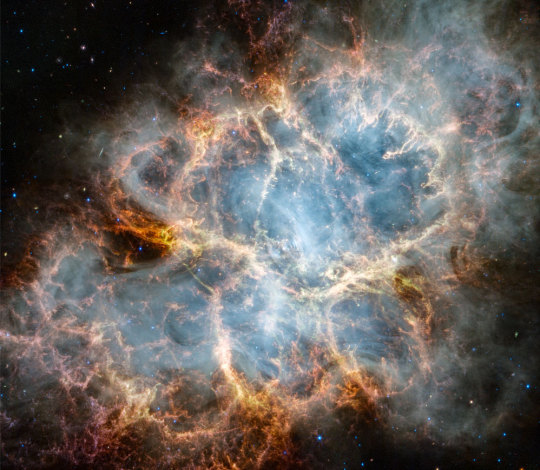
M1: The Incredible Expanding Crab ©
#nasa#apod#messeir 1#crab nebula#astrophotography#space#solar system#planet#galaxy#stars#universe#astronomy#cosmos
881 notes
·
View notes
Text
Y'all, I'm getting emotional.
One of my absolute favorite astronomical bodies is the Crab Nebula, or Messier 1. The Crab Nebula is a "planetary nebula", which means it's the enormous, beautiful corpse of a once-giant star. The star that formed the Crab Nebula went supernova and exploded in 1054, and was so bright at the time of its death that you could see it from Earth during the day - for almost a month. For that month, it was brighter than every single thing in the sky except the moon and the sun. Some of you have probably heard of it, or have at least seen this Hubble picture:

But how many of y'all have zoomed in?
Inside all of those lovely rainbow clouds is the supernova remnant - a neutron star. A neutron star is made of the densest possible material that we know of - any denser, and it'd collapse the rest of the way into a full-fledged black hole. Neutron stars are so unimaginably dense that they're not even made of an element, not really. The star at the center of the Crab Nebula is one, single atomic nucleus 12 miles in diameter, made entirely of close-packed neutrons. One teaspoon would weigh 10 million tons. Imagine taking a passenger jet, condensing it down to the size of a mote of dust, and then filling a spoon with that dust. And it spins too - 30 times a second. That spinning causes huge jets of material to eject from the poles at half the speed of light. The incredibly powerful magnetic field traps any stray particles and accelerates them in circular paths through the nebula. Just LOOK at this shit! See the ghosty shadows of the jets, stretching from the top left corner to the bottom right?

But what's really making me lose it is this Hubble timelapse. The star is making ripples. Its moving. Its been dead for almost a thousand years, but its still putting on its final, spectacular show.
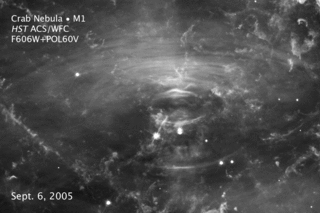
It never ceases to amaze me that the things we call "dead" stars are some of the most dynamic, energetic, and awe-inspiring objects in the universe. Normal stars are downright STAGNANT compared to what these so-called "stellar remnants" get up to. Maybe we shouldn't be thinking of them as dead stars, but as the next phase in a star's life. Just as caterpillars "end" their mundane lives and metamorphose into something new and strange and capable of flight, these stars destroy themselves to leave behind something far more exotic, playing at the edge of the laws of physics in ways we still don't fully understand.
#space#crab nebula#neutron star#supernova#god I fucking love neutron stars#ask me sometime about the first pulsar#hubble#spost#space post
739 notes
·
View notes
Text

Crab Nebula as captured by the James Webb Space Telescope (30 October 2023)
#space#james webb space telescope#james webb#crab nebula#astrophotography#james webb images#nebula#nasa#cosmos#oh my gods this is so fucking beautiful#science#astronomy
428 notes
·
View notes
Text

The Crab Nebula, M1 // Ivaylo Stoynov
#astronomy#astrophotography#nebula#emission nebula#supernova remnant#crab nebula#messier#messier 1#M1#NGC 1952#taurus#Sh2-244
310 notes
·
View notes
Text

Messier 1, Also known as the Crab Nebula, a supernova remnant in the constellation of Taurus as seen by the Hubble Space Telescope. (Image Credits go to NASA/ESA)
185 notes
·
View notes
Text

High Energy Astronomy Observatory (HEAO)-2/Einstein Observatory: X-ray image of the Crab Nebula (January 1, 1979)
#heao#high energy astronomy observatory#einstein observatory#astronomy#krakenmare#astrophotography#outer space#nasa#crab nebula#nebula#nebulas
98 notes
·
View notes
Text

M1 the Crab Nebula. A supernova remnant and pulsar wind nebula 6,500 ly away sitting on the tip top of the left horn of Taurus the Bull. Had difficulty editing this one and not sure if I'm fully happy with it, but it'll do because I'm tired.
109 notes
·
View notes
Text
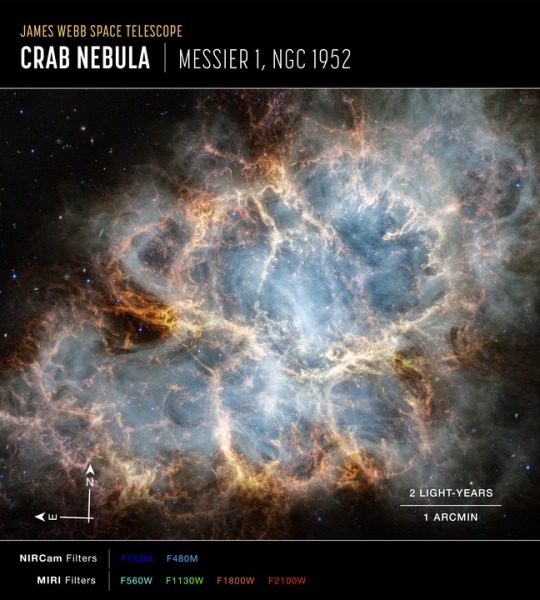
#hiyutekivigil#james webb space telescope#james webb telescope#james webb#james webb photos#james webb update#webb#crab nebula#space#space photography#astronomy#stem#stem academia#academia#academia aesthetic
103 notes
·
View notes
Text
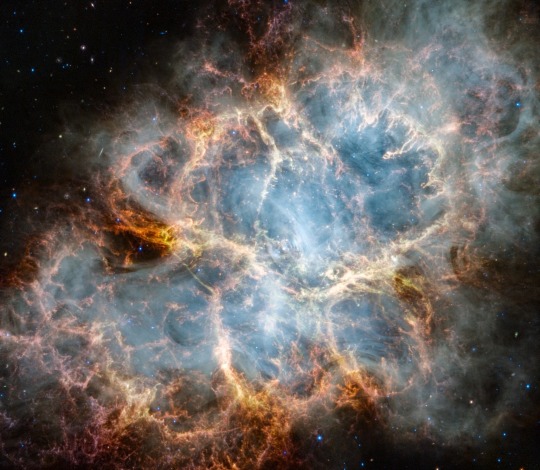
Crab Nebula, taken by the James Webb Space Telescope’s NIRCam (Near-Infrared Camera) & MIRI (Mid-Infrared Instrument)
Published by NASA 10/30/23
#photography#space#telescope#james webb space telescope#nebula#crab nebula#universe#stars#infrared#astronomy#galaxies#discovery#science#nasa
101 notes
·
View notes
Text

Crab Nebula
139 notes
·
View notes
Photo

Swirling Core of the Crab Nebula
#space#astronomy#astrophotography#universe#stars#crab nebula#planet#galaxy#planets#solar system#night#sky#nasa
3K notes
·
View notes
Text
Crab Nebula (Final Product)

Here I present to you the final product of my Crab Nebula image. I was fairly happy with the previous product but there were two slight issues I developed with it over time. Firstly, the previous image felt like it had an unnatural vibrance to it, as if the saturation had been turned up to one hundred. To fix this, I simply desaturated the entire image by thirty percent. Then, I found that the unfinished version of the image was missing details to fill out certain spots in the frame. After reanalyzing a few of the black and whites, I found there were some stars that I didn’t highlight before. To fix this, I relayered stars behind my original image by overlaying them and setting the blend mode on Photoshop to “screen.” This is the point at which I stopped with the image because I was happy with how it turned out. As my first project in astrophotography, this image, I think, is the best I could’ve asked for. I maintained the significant details of the Crab Nebula well and colored it in a way that is satisfactory to the eyes. My ultimate goal with the final product was to have every spot on the image be beautiful to its own degree, and I believe I have done this well. This project not only developed my interest in astrophotography, but greatly improved my proficiency with Photoshop in the process. If there was anything I could have done better with this image, it would be to zoom in and try to encapsulate a closer look into the nebula itself, but with the stills I had been provided, I think I did a good job.
17 notes
·
View notes
Text

The Crab Nebula, M1 // NHAuniverse
The Crab Nebula is the only supernova remnant in the catalog. This was not an original discovery by Messier, having been discovered several decades earlier in 1731. The name comes from a drawing of the object that somewhat resembles a crab with arms produced by William Parsons in 1842.
#astronomy#astrophotography#messier marathon#nebula#emission nebula#supernova remnant#crab nebula#messier#messier 1#M1#NGC 1952#Taurus A#taurus
59 notes
·
View notes
Text
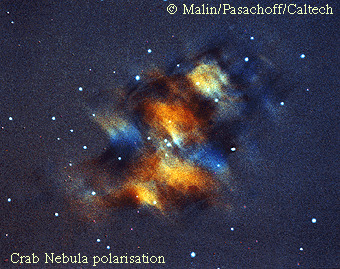
M1: Polarisation of the Crab - November 23rd, 1995.
"Although the stellar explosion that caused the Crab Nebula was seen over 900 years ago, the nebula itself still expands and shines. Much of the emitted light has been found to be polarised. Light waves with the same polarisation vibrate in the same plane. Light waves can be polarised by reflection from a surface, an effect familiar to sunglass wearing fishermen and skiers. Polarised light can also be emitted by regions that contain strong magnetic fields. Areas of different polarisation above are highlighted by different colours. Mapping the polarisation helps astronomers decipher which physical processes create the observed light."
33 notes
·
View notes
Text

Hale Observatory optical telescope: Crab Nebula in visible light (January 1, 1959)
41 notes
·
View notes
